BUSSH5R54 - Lean Manufacturing: Implementing 'Respect for People'
VerifiedAdded on 2023/04/22
|17
|3766
|483
Essay
AI Summary
This essay examines the contemporary view of Lean Manufacturing, emphasizing continuous development and respect for people. It discusses the two pillars of Lean Management: continuous improvement and respect for people, and explores barriers to Lean implementation. The essay also analyzes change implementation for improved organizational performance, the potential growth of continuous improvement, and the implementation of Six Sigma. Furthermore, it highlights how the 'Respect for People' principle is crucial for the successful implementation of Lean, fostering a lean culture throughout the organization and promoting employee engagement and understanding of Lean procedures.
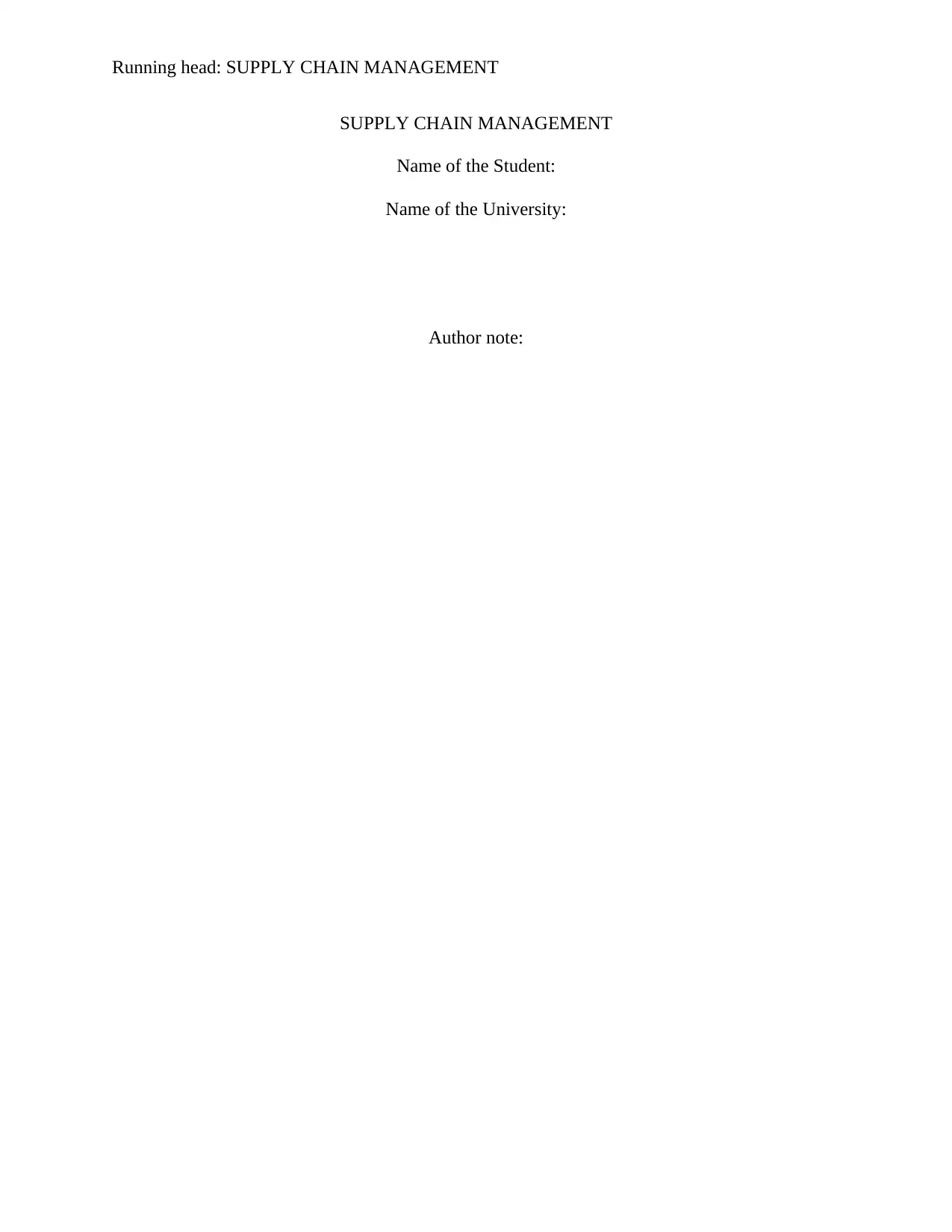
Running head: SUPPLY CHAIN MANAGEMENT
SUPPLY CHAIN MANAGEMENT
Name of the Student:
Name of the University:
Author note:
SUPPLY CHAIN MANAGEMENT
Name of the Student:
Name of the University:
Author note:
Paraphrase This Document
Need a fresh take? Get an instant paraphrase of this document with our AI Paraphraser
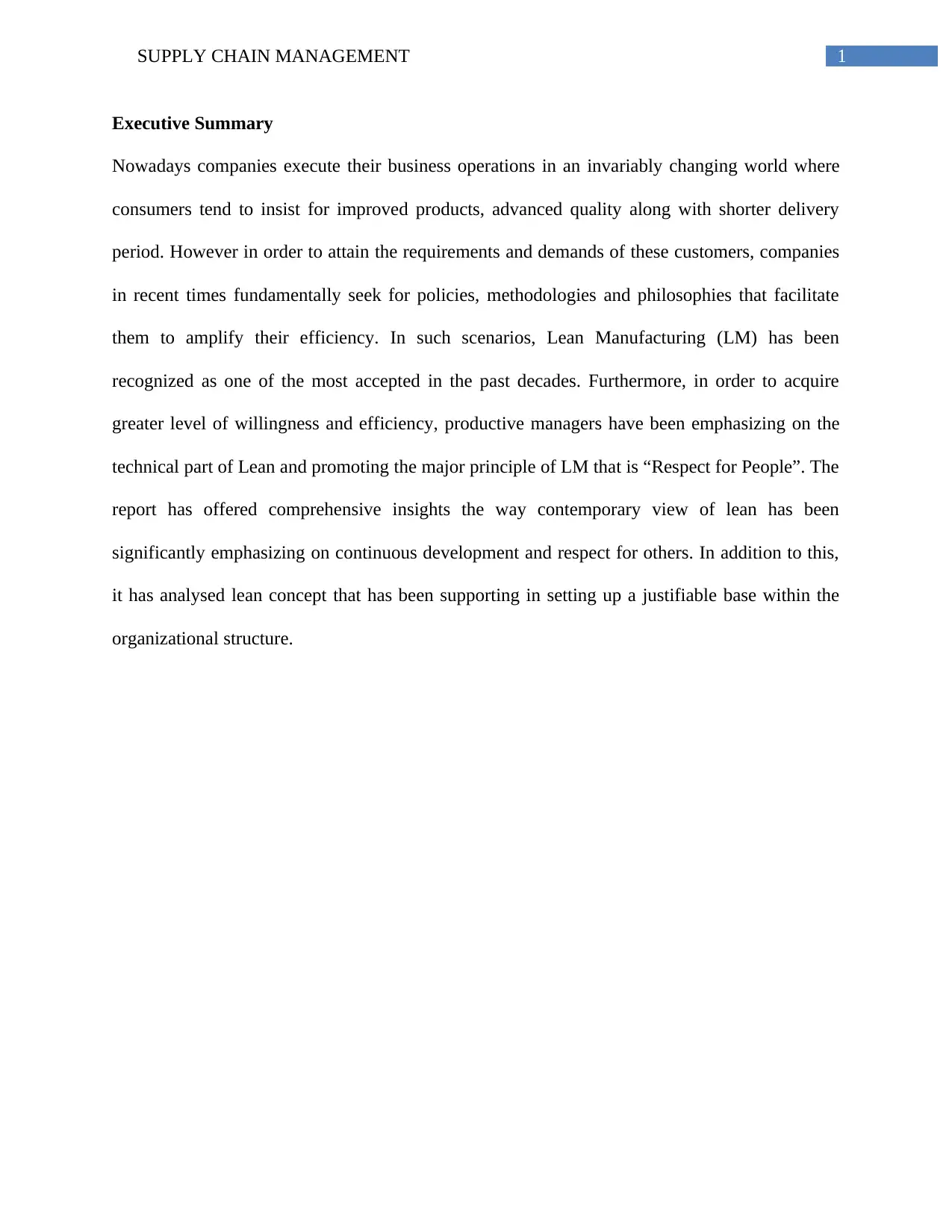
1SUPPLY CHAIN MANAGEMENT
Executive Summary
Nowadays companies execute their business operations in an invariably changing world where
consumers tend to insist for improved products, advanced quality along with shorter delivery
period. However in order to attain the requirements and demands of these customers, companies
in recent times fundamentally seek for policies, methodologies and philosophies that facilitate
them to amplify their efficiency. In such scenarios, Lean Manufacturing (LM) has been
recognized as one of the most accepted in the past decades. Furthermore, in order to acquire
greater level of willingness and efficiency, productive managers have been emphasizing on the
technical part of Lean and promoting the major principle of LM that is “Respect for People”. The
report has offered comprehensive insights the way contemporary view of lean has been
significantly emphasizing on continuous development and respect for others. In addition to this,
it has analysed lean concept that has been supporting in setting up a justifiable base within the
organizational structure.
Executive Summary
Nowadays companies execute their business operations in an invariably changing world where
consumers tend to insist for improved products, advanced quality along with shorter delivery
period. However in order to attain the requirements and demands of these customers, companies
in recent times fundamentally seek for policies, methodologies and philosophies that facilitate
them to amplify their efficiency. In such scenarios, Lean Manufacturing (LM) has been
recognized as one of the most accepted in the past decades. Furthermore, in order to acquire
greater level of willingness and efficiency, productive managers have been emphasizing on the
technical part of Lean and promoting the major principle of LM that is “Respect for People”. The
report has offered comprehensive insights the way contemporary view of lean has been
significantly emphasizing on continuous development and respect for others. In addition to this,
it has analysed lean concept that has been supporting in setting up a justifiable base within the
organizational structure.
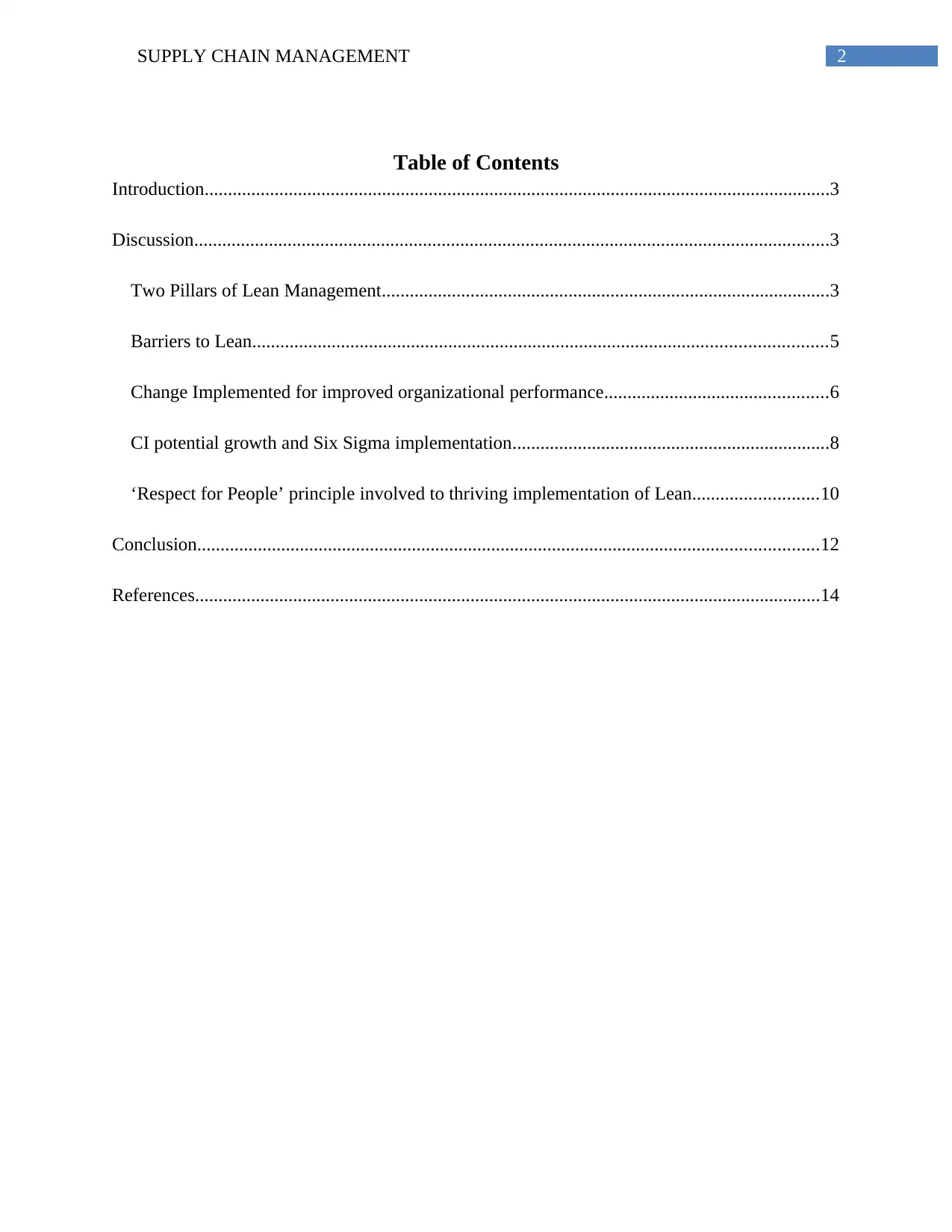
2SUPPLY CHAIN MANAGEMENT
Table of Contents
Introduction......................................................................................................................................3
Discussion........................................................................................................................................3
Two Pillars of Lean Management................................................................................................3
Barriers to Lean...........................................................................................................................5
Change Implemented for improved organizational performance................................................6
CI potential growth and Six Sigma implementation....................................................................8
‘Respect for People’ principle involved to thriving implementation of Lean...........................10
Conclusion.....................................................................................................................................12
References......................................................................................................................................14
Table of Contents
Introduction......................................................................................................................................3
Discussion........................................................................................................................................3
Two Pillars of Lean Management................................................................................................3
Barriers to Lean...........................................................................................................................5
Change Implemented for improved organizational performance................................................6
CI potential growth and Six Sigma implementation....................................................................8
‘Respect for People’ principle involved to thriving implementation of Lean...........................10
Conclusion.....................................................................................................................................12
References......................................................................................................................................14
⊘ This is a preview!⊘
Do you want full access?
Subscribe today to unlock all pages.

Trusted by 1+ million students worldwide
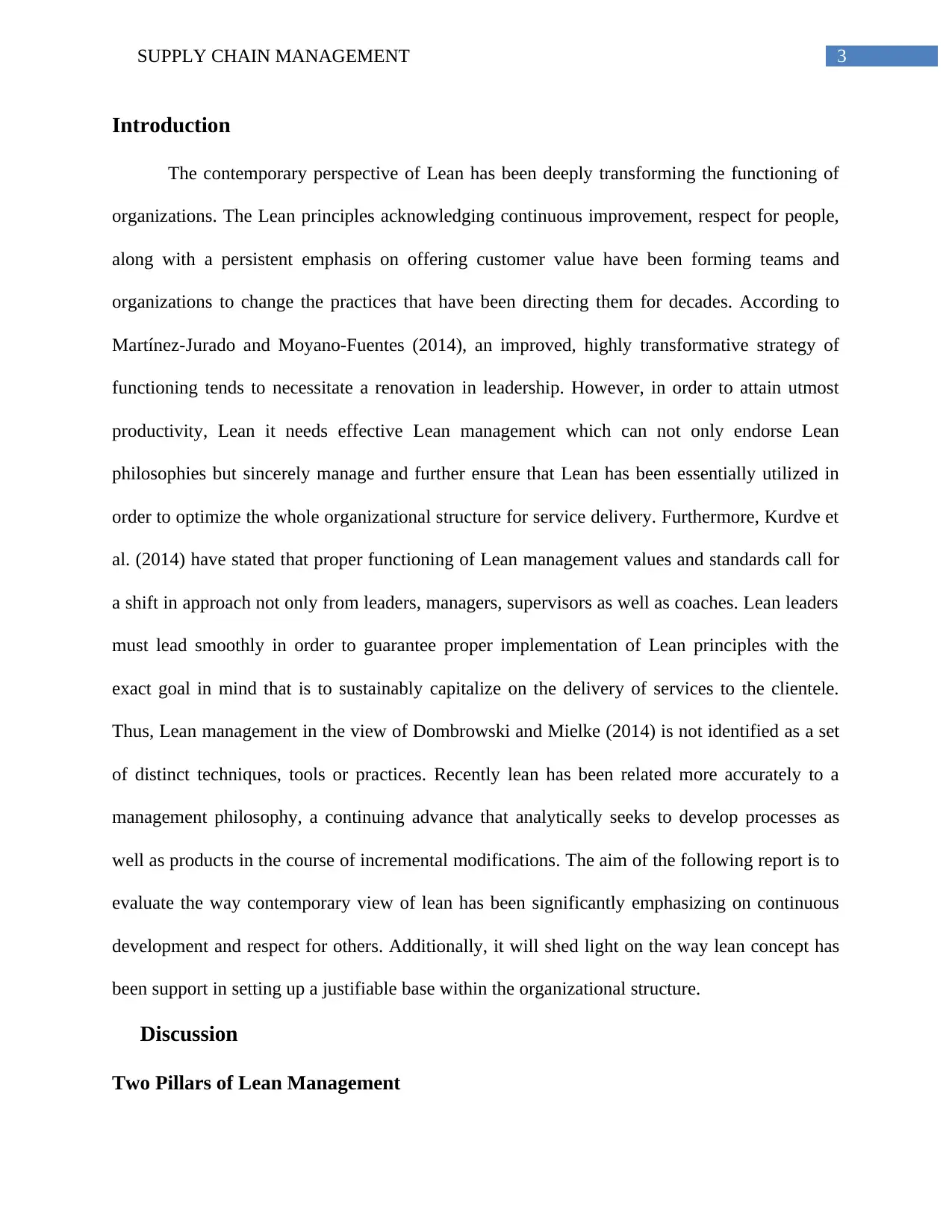
3SUPPLY CHAIN MANAGEMENT
Introduction
The contemporary perspective of Lean has been deeply transforming the functioning of
organizations. The Lean principles acknowledging continuous improvement, respect for people,
along with a persistent emphasis on offering customer value have been forming teams and
organizations to change the practices that have been directing them for decades. According to
Martínez-Jurado and Moyano-Fuentes (2014), an improved, highly transformative strategy of
functioning tends to necessitate a renovation in leadership. However, in order to attain utmost
productivity, Lean it needs effective Lean management which can not only endorse Lean
philosophies but sincerely manage and further ensure that Lean has been essentially utilized in
order to optimize the whole organizational structure for service delivery. Furthermore, Kurdve et
al. (2014) have stated that proper functioning of Lean management values and standards call for
a shift in approach not only from leaders, managers, supervisors as well as coaches. Lean leaders
must lead smoothly in order to guarantee proper implementation of Lean principles with the
exact goal in mind that is to sustainably capitalize on the delivery of services to the clientele.
Thus, Lean management in the view of Dombrowski and Mielke (2014) is not identified as a set
of distinct techniques, tools or practices. Recently lean has been related more accurately to a
management philosophy, a continuing advance that analytically seeks to develop processes as
well as products in the course of incremental modifications. The aim of the following report is to
evaluate the way contemporary view of lean has been significantly emphasizing on continuous
development and respect for others. Additionally, it will shed light on the way lean concept has
been support in setting up a justifiable base within the organizational structure.
Discussion
Two Pillars of Lean Management
Introduction
The contemporary perspective of Lean has been deeply transforming the functioning of
organizations. The Lean principles acknowledging continuous improvement, respect for people,
along with a persistent emphasis on offering customer value have been forming teams and
organizations to change the practices that have been directing them for decades. According to
Martínez-Jurado and Moyano-Fuentes (2014), an improved, highly transformative strategy of
functioning tends to necessitate a renovation in leadership. However, in order to attain utmost
productivity, Lean it needs effective Lean management which can not only endorse Lean
philosophies but sincerely manage and further ensure that Lean has been essentially utilized in
order to optimize the whole organizational structure for service delivery. Furthermore, Kurdve et
al. (2014) have stated that proper functioning of Lean management values and standards call for
a shift in approach not only from leaders, managers, supervisors as well as coaches. Lean leaders
must lead smoothly in order to guarantee proper implementation of Lean principles with the
exact goal in mind that is to sustainably capitalize on the delivery of services to the clientele.
Thus, Lean management in the view of Dombrowski and Mielke (2014) is not identified as a set
of distinct techniques, tools or practices. Recently lean has been related more accurately to a
management philosophy, a continuing advance that analytically seeks to develop processes as
well as products in the course of incremental modifications. The aim of the following report is to
evaluate the way contemporary view of lean has been significantly emphasizing on continuous
development and respect for others. Additionally, it will shed light on the way lean concept has
been support in setting up a justifiable base within the organizational structure.
Discussion
Two Pillars of Lean Management
Paraphrase This Document
Need a fresh take? Get an instant paraphrase of this document with our AI Paraphraser
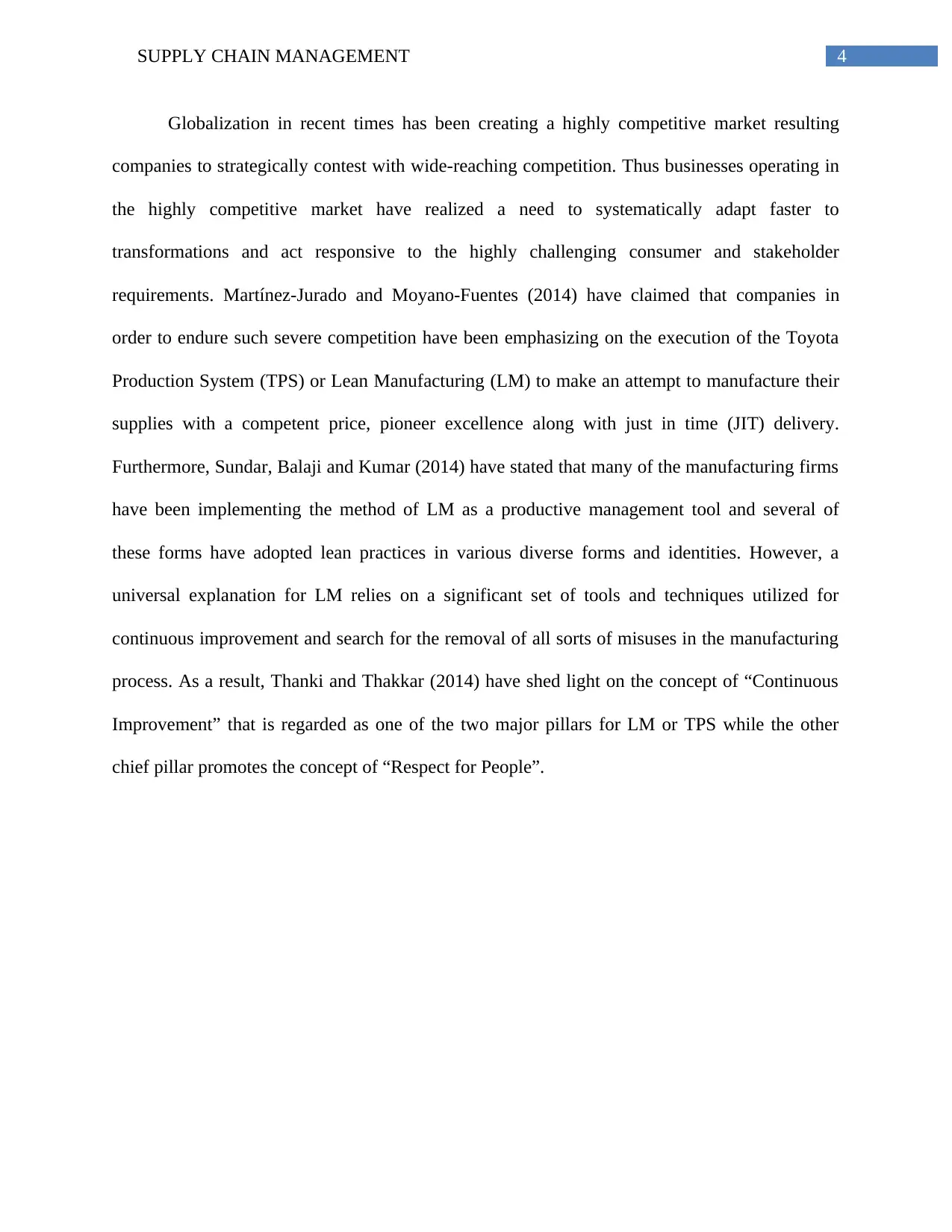
4SUPPLY CHAIN MANAGEMENT
Globalization in recent times has been creating a highly competitive market resulting
companies to strategically contest with wide-reaching competition. Thus businesses operating in
the highly competitive market have realized a need to systematically adapt faster to
transformations and act responsive to the highly challenging consumer and stakeholder
requirements. Martínez-Jurado and Moyano-Fuentes (2014) have claimed that companies in
order to endure such severe competition have been emphasizing on the execution of the Toyota
Production System (TPS) or Lean Manufacturing (LM) to make an attempt to manufacture their
supplies with a competent price, pioneer excellence along with just in time (JIT) delivery.
Furthermore, Sundar, Balaji and Kumar (2014) have stated that many of the manufacturing firms
have been implementing the method of LM as a productive management tool and several of
these forms have adopted lean practices in various diverse forms and identities. However, a
universal explanation for LM relies on a significant set of tools and techniques utilized for
continuous improvement and search for the removal of all sorts of misuses in the manufacturing
process. As a result, Thanki and Thakkar (2014) have shed light on the concept of “Continuous
Improvement” that is regarded as one of the two major pillars for LM or TPS while the other
chief pillar promotes the concept of “Respect for People”.
Globalization in recent times has been creating a highly competitive market resulting
companies to strategically contest with wide-reaching competition. Thus businesses operating in
the highly competitive market have realized a need to systematically adapt faster to
transformations and act responsive to the highly challenging consumer and stakeholder
requirements. Martínez-Jurado and Moyano-Fuentes (2014) have claimed that companies in
order to endure such severe competition have been emphasizing on the execution of the Toyota
Production System (TPS) or Lean Manufacturing (LM) to make an attempt to manufacture their
supplies with a competent price, pioneer excellence along with just in time (JIT) delivery.
Furthermore, Sundar, Balaji and Kumar (2014) have stated that many of the manufacturing firms
have been implementing the method of LM as a productive management tool and several of
these forms have adopted lean practices in various diverse forms and identities. However, a
universal explanation for LM relies on a significant set of tools and techniques utilized for
continuous improvement and search for the removal of all sorts of misuses in the manufacturing
process. As a result, Thanki and Thakkar (2014) have shed light on the concept of “Continuous
Improvement” that is regarded as one of the two major pillars for LM or TPS while the other
chief pillar promotes the concept of “Respect for People”.
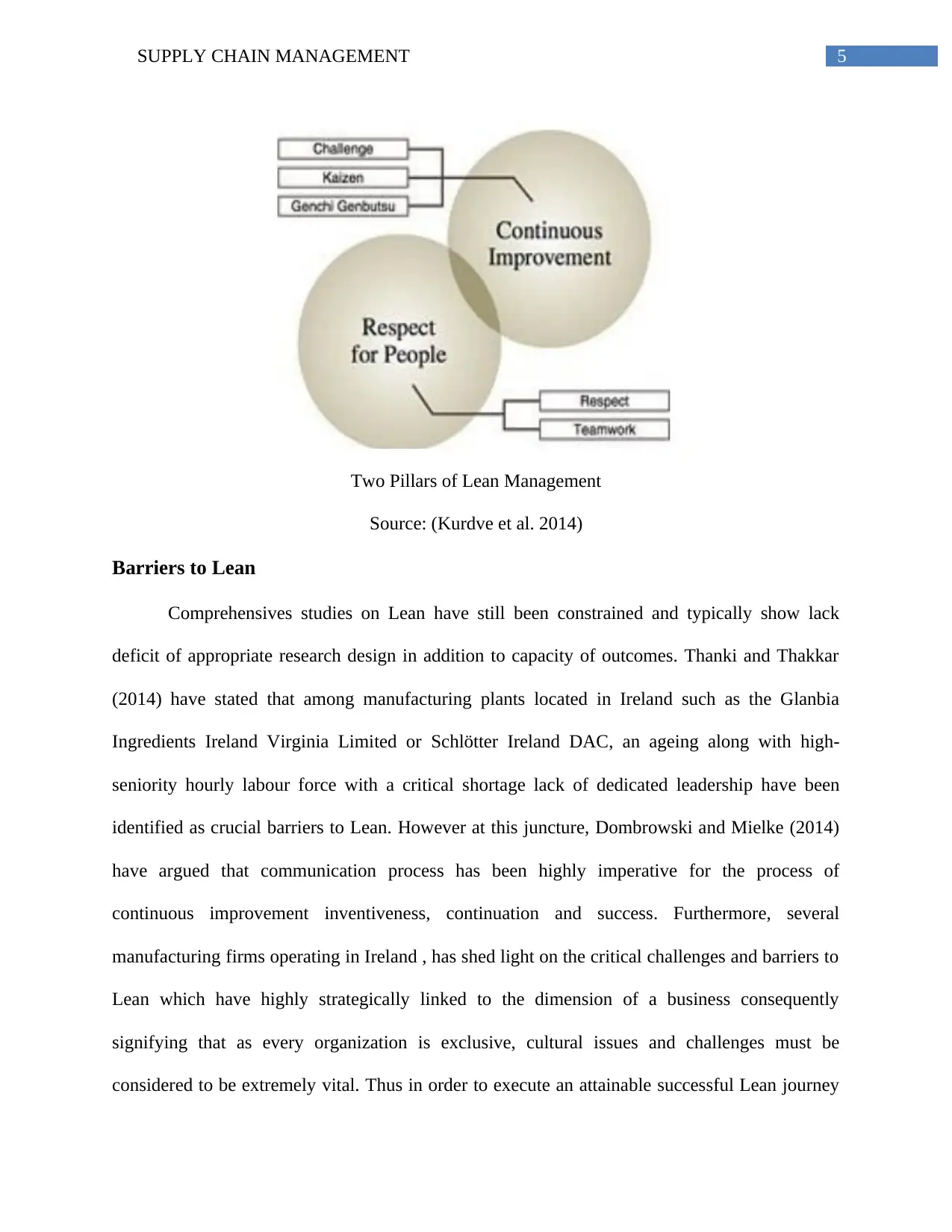
5SUPPLY CHAIN MANAGEMENT
Two Pillars of Lean Management
Source: (Kurdve et al. 2014)
Barriers to Lean
Comprehensives studies on Lean have still been constrained and typically show lack
deficit of appropriate research design in addition to capacity of outcomes. Thanki and Thakkar
(2014) have stated that among manufacturing plants located in Ireland such as the Glanbia
Ingredients Ireland Virginia Limited or Schlötter Ireland DAC, an ageing along with high-
seniority hourly labour force with a critical shortage lack of dedicated leadership have been
identified as crucial barriers to Lean. However at this juncture, Dombrowski and Mielke (2014)
have argued that communication process has been highly imperative for the process of
continuous improvement inventiveness, continuation and success. Furthermore, several
manufacturing firms operating in Ireland , has shed light on the critical challenges and barriers to
Lean which have highly strategically linked to the dimension of a business consequently
signifying that as every organization is exclusive, cultural issues and challenges must be
considered to be extremely vital. Thus in order to execute an attainable successful Lean journey
Two Pillars of Lean Management
Source: (Kurdve et al. 2014)
Barriers to Lean
Comprehensives studies on Lean have still been constrained and typically show lack
deficit of appropriate research design in addition to capacity of outcomes. Thanki and Thakkar
(2014) have stated that among manufacturing plants located in Ireland such as the Glanbia
Ingredients Ireland Virginia Limited or Schlötter Ireland DAC, an ageing along with high-
seniority hourly labour force with a critical shortage lack of dedicated leadership have been
identified as crucial barriers to Lean. However at this juncture, Dombrowski and Mielke (2014)
have argued that communication process has been highly imperative for the process of
continuous improvement inventiveness, continuation and success. Furthermore, several
manufacturing firms operating in Ireland , has shed light on the critical challenges and barriers to
Lean which have highly strategically linked to the dimension of a business consequently
signifying that as every organization is exclusive, cultural issues and challenges must be
considered to be extremely vital. Thus in order to execute an attainable successful Lean journey
⊘ This is a preview!⊘
Do you want full access?
Subscribe today to unlock all pages.

Trusted by 1+ million students worldwide
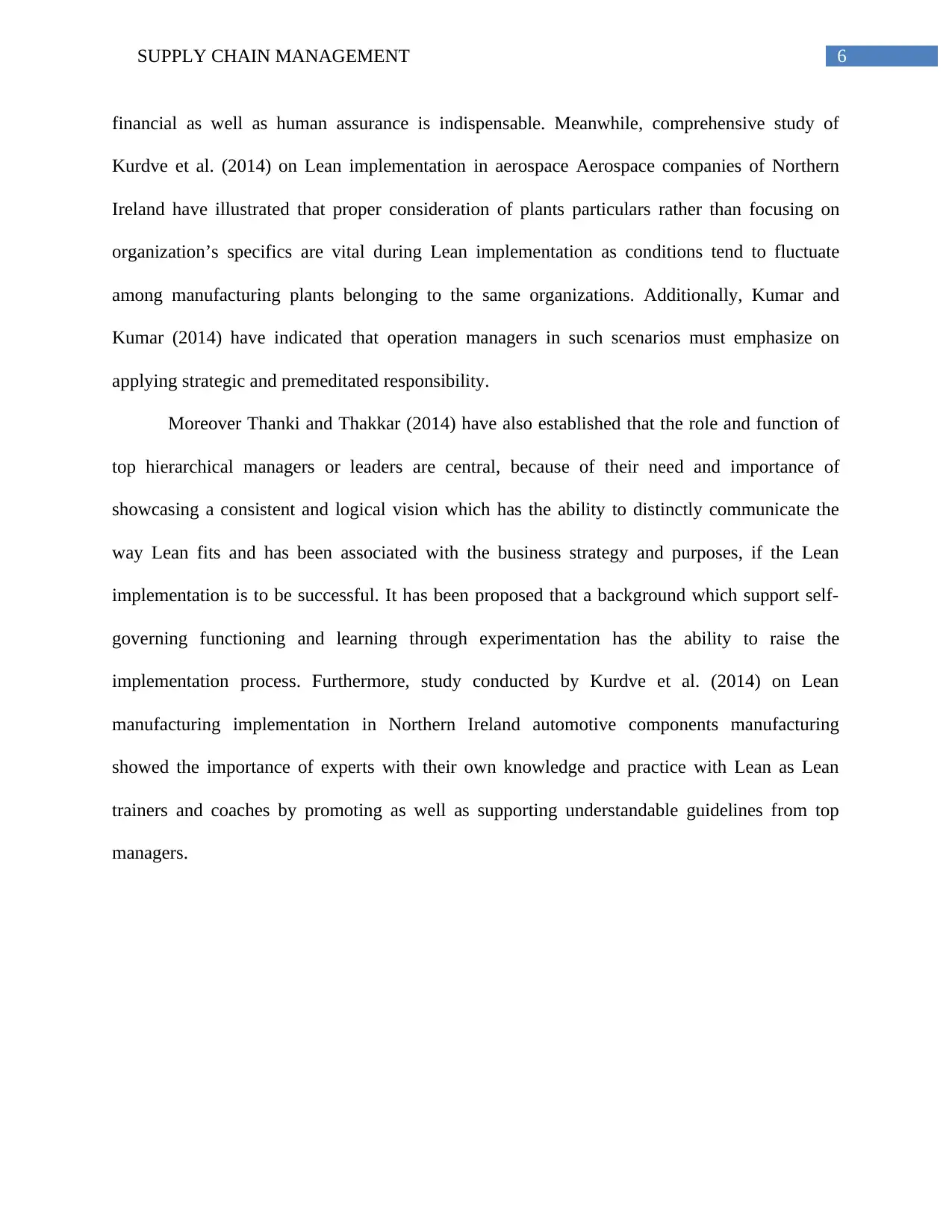
6SUPPLY CHAIN MANAGEMENT
financial as well as human assurance is indispensable. Meanwhile, comprehensive study of
Kurdve et al. (2014) on Lean implementation in aerospace Aerospace companies of Northern
Ireland have illustrated that proper consideration of plants particulars rather than focusing on
organization’s specifics are vital during Lean implementation as conditions tend to fluctuate
among manufacturing plants belonging to the same organizations. Additionally, Kumar and
Kumar (2014) have indicated that operation managers in such scenarios must emphasize on
applying strategic and premeditated responsibility.
Moreover Thanki and Thakkar (2014) have also established that the role and function of
top hierarchical managers or leaders are central, because of their need and importance of
showcasing a consistent and logical vision which has the ability to distinctly communicate the
way Lean fits and has been associated with the business strategy and purposes, if the Lean
implementation is to be successful. It has been proposed that a background which support self-
governing functioning and learning through experimentation has the ability to raise the
implementation process. Furthermore, study conducted by Kurdve et al. (2014) on Lean
manufacturing implementation in Northern Ireland automotive components manufacturing
showed the importance of experts with their own knowledge and practice with Lean as Lean
trainers and coaches by promoting as well as supporting understandable guidelines from top
managers.
financial as well as human assurance is indispensable. Meanwhile, comprehensive study of
Kurdve et al. (2014) on Lean implementation in aerospace Aerospace companies of Northern
Ireland have illustrated that proper consideration of plants particulars rather than focusing on
organization’s specifics are vital during Lean implementation as conditions tend to fluctuate
among manufacturing plants belonging to the same organizations. Additionally, Kumar and
Kumar (2014) have indicated that operation managers in such scenarios must emphasize on
applying strategic and premeditated responsibility.
Moreover Thanki and Thakkar (2014) have also established that the role and function of
top hierarchical managers or leaders are central, because of their need and importance of
showcasing a consistent and logical vision which has the ability to distinctly communicate the
way Lean fits and has been associated with the business strategy and purposes, if the Lean
implementation is to be successful. It has been proposed that a background which support self-
governing functioning and learning through experimentation has the ability to raise the
implementation process. Furthermore, study conducted by Kurdve et al. (2014) on Lean
manufacturing implementation in Northern Ireland automotive components manufacturing
showed the importance of experts with their own knowledge and practice with Lean as Lean
trainers and coaches by promoting as well as supporting understandable guidelines from top
managers.
Paraphrase This Document
Need a fresh take? Get an instant paraphrase of this document with our AI Paraphraser
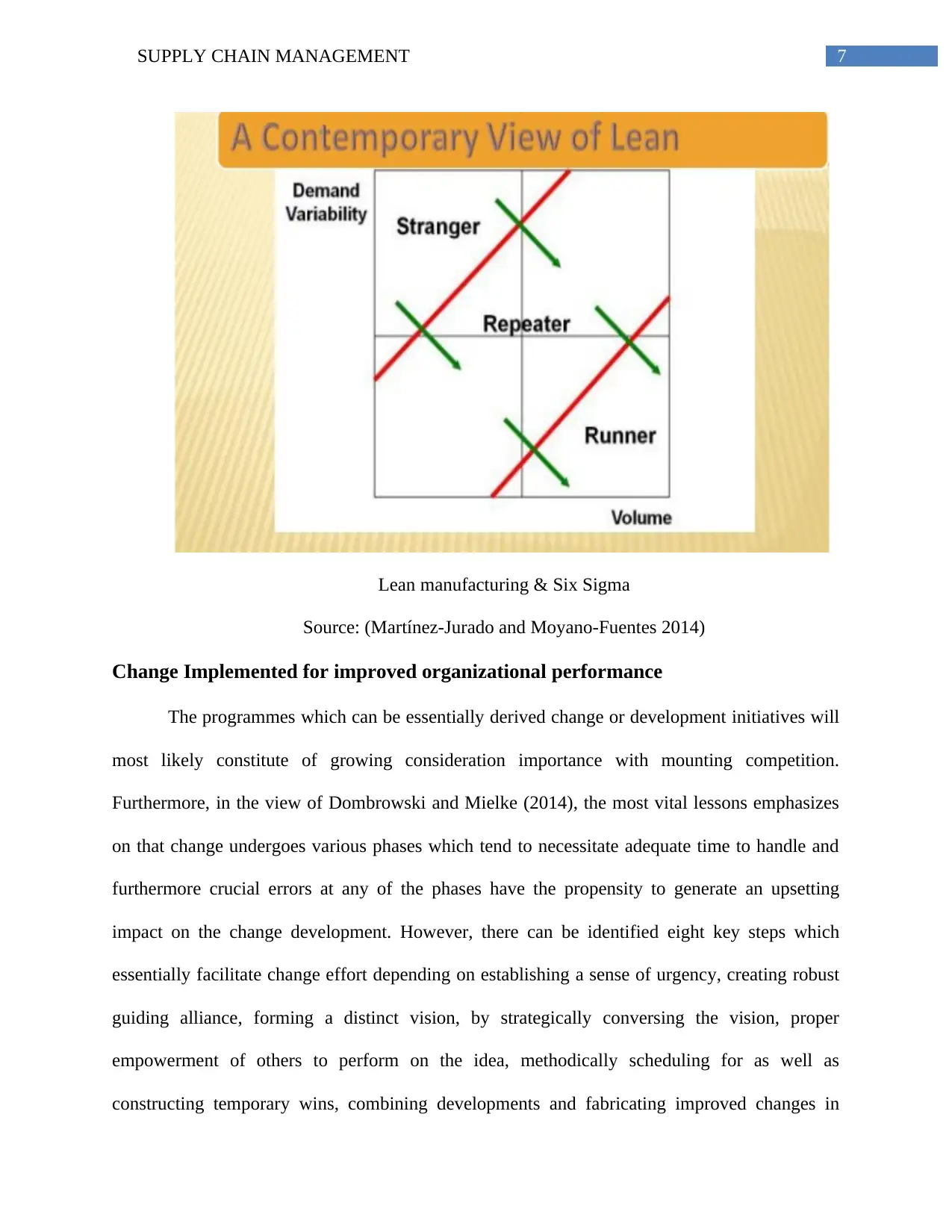
7SUPPLY CHAIN MANAGEMENT
Lean manufacturing & Six Sigma
Source: (Martínez-Jurado and Moyano-Fuentes 2014)
Change Implemented for improved organizational performance
The programmes which can be essentially derived change or development initiatives will
most likely constitute of growing consideration importance with mounting competition.
Furthermore, in the view of Dombrowski and Mielke (2014), the most vital lessons emphasizes
on that change undergoes various phases which tend to necessitate adequate time to handle and
furthermore crucial errors at any of the phases have the propensity to generate an upsetting
impact on the change development. However, there can be identified eight key steps which
essentially facilitate change effort depending on establishing a sense of urgency, creating robust
guiding alliance, forming a distinct vision, by strategically conversing the vision, proper
empowerment of others to perform on the idea, methodically scheduling for as well as
constructing temporary wins, combining developments and fabricating improved changes in
Lean manufacturing & Six Sigma
Source: (Martínez-Jurado and Moyano-Fuentes 2014)
Change Implemented for improved organizational performance
The programmes which can be essentially derived change or development initiatives will
most likely constitute of growing consideration importance with mounting competition.
Furthermore, in the view of Dombrowski and Mielke (2014), the most vital lessons emphasizes
on that change undergoes various phases which tend to necessitate adequate time to handle and
furthermore crucial errors at any of the phases have the propensity to generate an upsetting
impact on the change development. However, there can be identified eight key steps which
essentially facilitate change effort depending on establishing a sense of urgency, creating robust
guiding alliance, forming a distinct vision, by strategically conversing the vision, proper
empowerment of others to perform on the idea, methodically scheduling for as well as
constructing temporary wins, combining developments and fabricating improved changes in
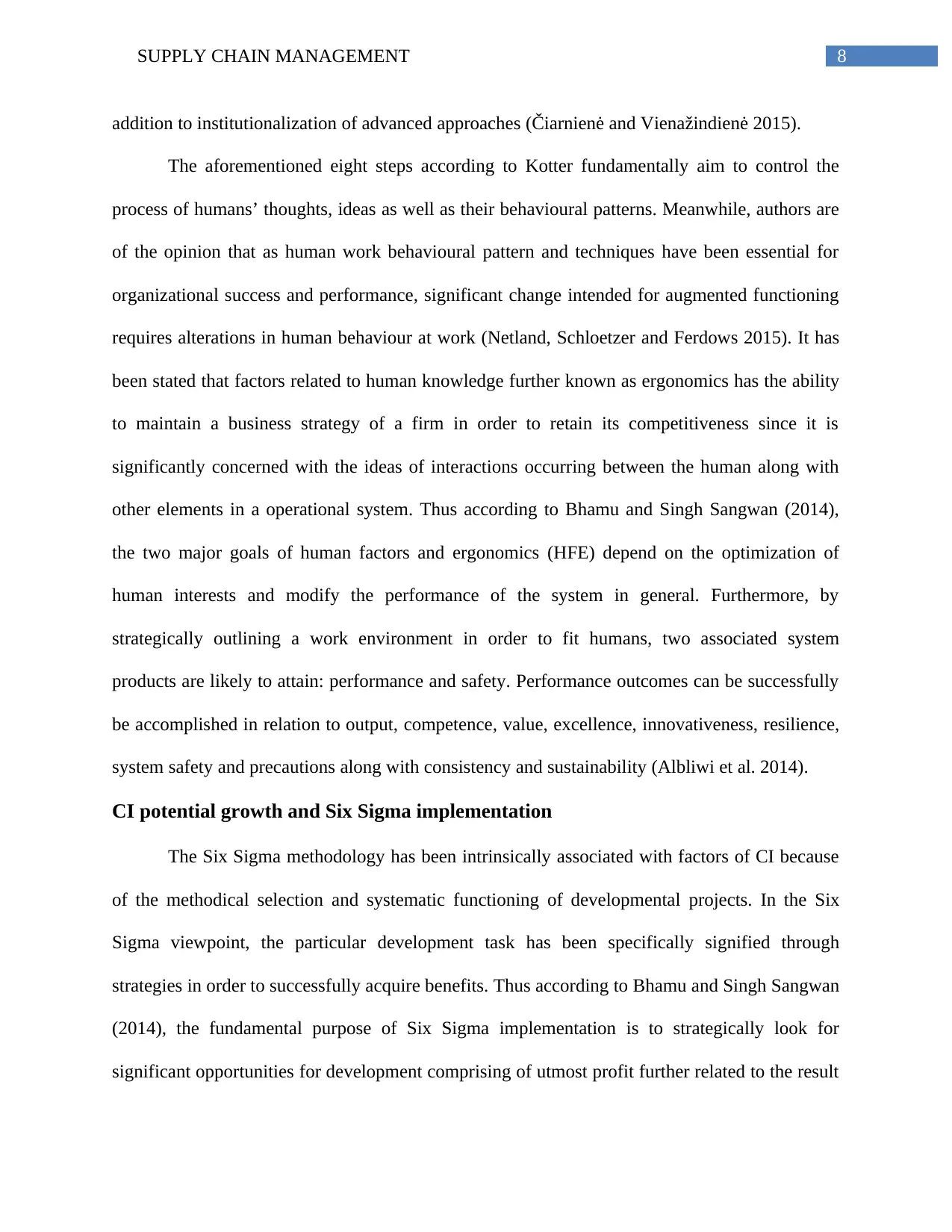
8SUPPLY CHAIN MANAGEMENT
addition to institutionalization of advanced approaches (Čiarnienė and Vienažindienė 2015).
The aforementioned eight steps according to Kotter fundamentally aim to control the
process of humans’ thoughts, ideas as well as their behavioural patterns. Meanwhile, authors are
of the opinion that as human work behavioural pattern and techniques have been essential for
organizational success and performance, significant change intended for augmented functioning
requires alterations in human behaviour at work (Netland, Schloetzer and Ferdows 2015). It has
been stated that factors related to human knowledge further known as ergonomics has the ability
to maintain a business strategy of a firm in order to retain its competitiveness since it is
significantly concerned with the ideas of interactions occurring between the human along with
other elements in a operational system. Thus according to Bhamu and Singh Sangwan (2014),
the two major goals of human factors and ergonomics (HFE) depend on the optimization of
human interests and modify the performance of the system in general. Furthermore, by
strategically outlining a work environment in order to fit humans, two associated system
products are likely to attain: performance and safety. Performance outcomes can be successfully
be accomplished in relation to output, competence, value, excellence, innovativeness, resilience,
system safety and precautions along with consistency and sustainability (Albliwi et al. 2014).
CI potential growth and Six Sigma implementation
The Six Sigma methodology has been intrinsically associated with factors of CI because
of the methodical selection and systematic functioning of developmental projects. In the Six
Sigma viewpoint, the particular development task has been specifically signified through
strategies in order to successfully acquire benefits. Thus according to Bhamu and Singh Sangwan
(2014), the fundamental purpose of Six Sigma implementation is to strategically look for
significant opportunities for development comprising of utmost profit further related to the result
addition to institutionalization of advanced approaches (Čiarnienė and Vienažindienė 2015).
The aforementioned eight steps according to Kotter fundamentally aim to control the
process of humans’ thoughts, ideas as well as their behavioural patterns. Meanwhile, authors are
of the opinion that as human work behavioural pattern and techniques have been essential for
organizational success and performance, significant change intended for augmented functioning
requires alterations in human behaviour at work (Netland, Schloetzer and Ferdows 2015). It has
been stated that factors related to human knowledge further known as ergonomics has the ability
to maintain a business strategy of a firm in order to retain its competitiveness since it is
significantly concerned with the ideas of interactions occurring between the human along with
other elements in a operational system. Thus according to Bhamu and Singh Sangwan (2014),
the two major goals of human factors and ergonomics (HFE) depend on the optimization of
human interests and modify the performance of the system in general. Furthermore, by
strategically outlining a work environment in order to fit humans, two associated system
products are likely to attain: performance and safety. Performance outcomes can be successfully
be accomplished in relation to output, competence, value, excellence, innovativeness, resilience,
system safety and precautions along with consistency and sustainability (Albliwi et al. 2014).
CI potential growth and Six Sigma implementation
The Six Sigma methodology has been intrinsically associated with factors of CI because
of the methodical selection and systematic functioning of developmental projects. In the Six
Sigma viewpoint, the particular development task has been specifically signified through
strategies in order to successfully acquire benefits. Thus according to Bhamu and Singh Sangwan
(2014), the fundamental purpose of Six Sigma implementation is to strategically look for
significant opportunities for development comprising of utmost profit further related to the result
⊘ This is a preview!⊘
Do you want full access?
Subscribe today to unlock all pages.

Trusted by 1+ million students worldwide
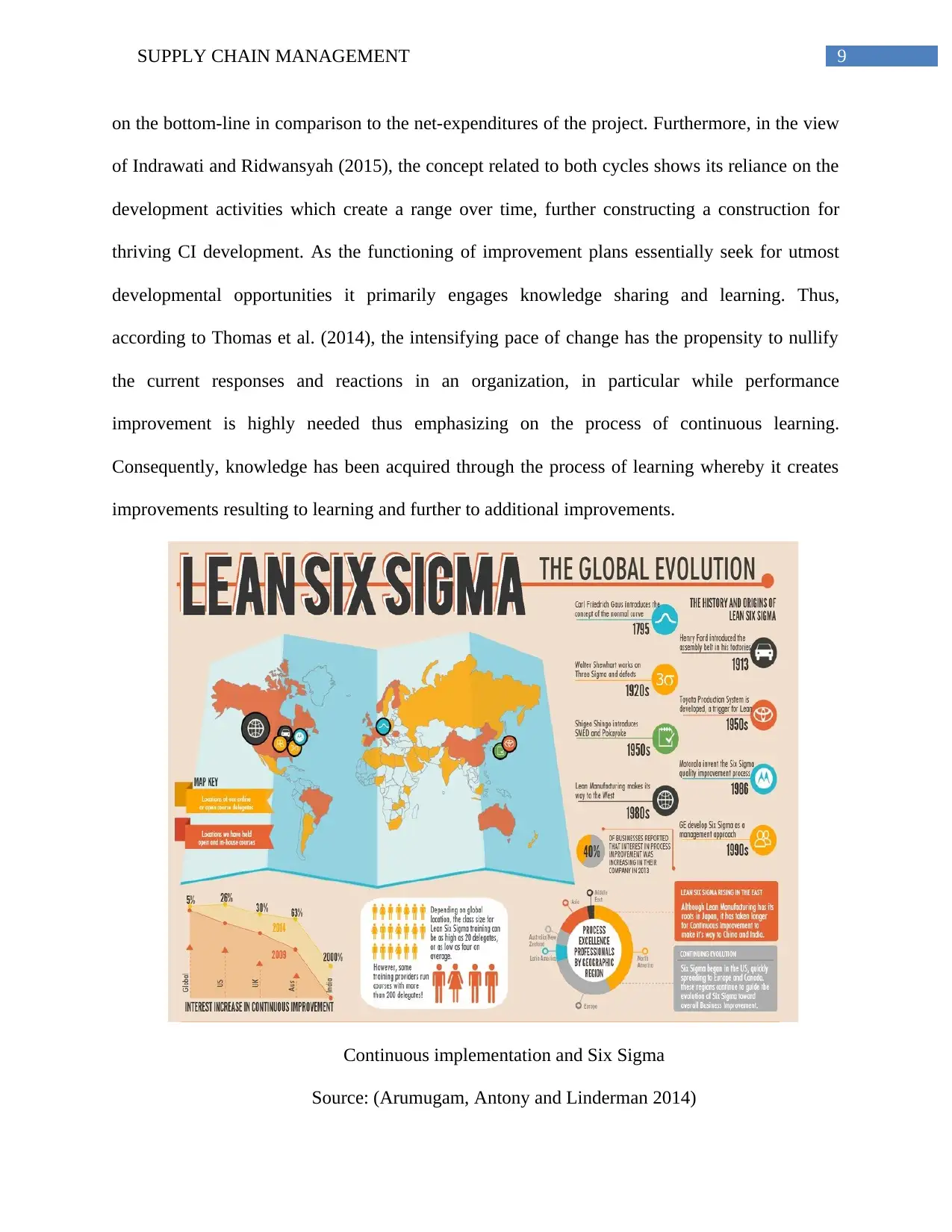
9SUPPLY CHAIN MANAGEMENT
on the bottom-line in comparison to the net-expenditures of the project. Furthermore, in the view
of Indrawati and Ridwansyah (2015), the concept related to both cycles shows its reliance on the
development activities which create a range over time, further constructing a construction for
thriving CI development. As the functioning of improvement plans essentially seek for utmost
developmental opportunities it primarily engages knowledge sharing and learning. Thus,
according to Thomas et al. (2014), the intensifying pace of change has the propensity to nullify
the current responses and reactions in an organization, in particular while performance
improvement is highly needed thus emphasizing on the process of continuous learning.
Consequently, knowledge has been acquired through the process of learning whereby it creates
improvements resulting to learning and further to additional improvements.
Continuous implementation and Six Sigma
Source: (Arumugam, Antony and Linderman 2014)
on the bottom-line in comparison to the net-expenditures of the project. Furthermore, in the view
of Indrawati and Ridwansyah (2015), the concept related to both cycles shows its reliance on the
development activities which create a range over time, further constructing a construction for
thriving CI development. As the functioning of improvement plans essentially seek for utmost
developmental opportunities it primarily engages knowledge sharing and learning. Thus,
according to Thomas et al. (2014), the intensifying pace of change has the propensity to nullify
the current responses and reactions in an organization, in particular while performance
improvement is highly needed thus emphasizing on the process of continuous learning.
Consequently, knowledge has been acquired through the process of learning whereby it creates
improvements resulting to learning and further to additional improvements.
Continuous implementation and Six Sigma
Source: (Arumugam, Antony and Linderman 2014)
Paraphrase This Document
Need a fresh take? Get an instant paraphrase of this document with our AI Paraphraser
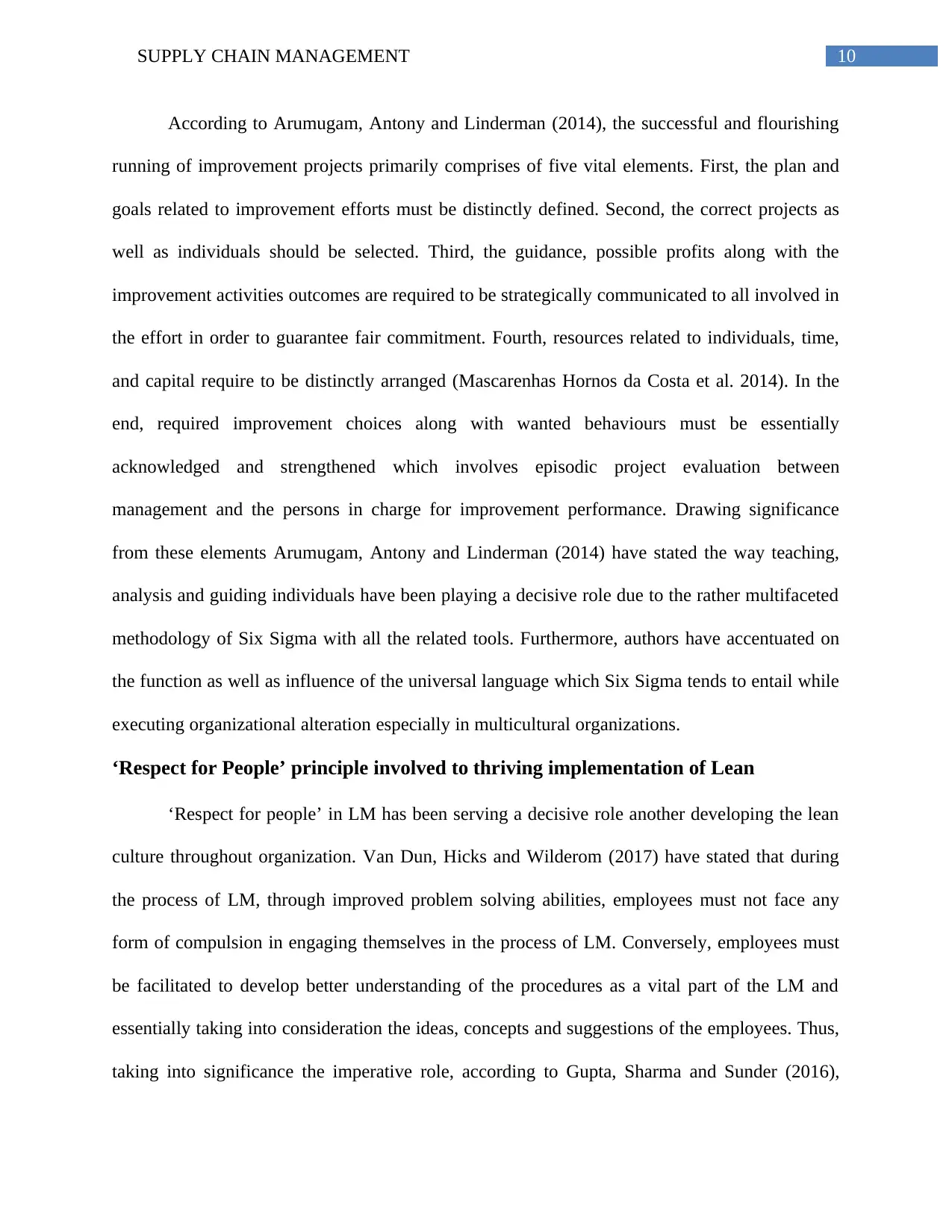
10SUPPLY CHAIN MANAGEMENT
According to Arumugam, Antony and Linderman (2014), the successful and flourishing
running of improvement projects primarily comprises of five vital elements. First, the plan and
goals related to improvement efforts must be distinctly defined. Second, the correct projects as
well as individuals should be selected. Third, the guidance, possible profits along with the
improvement activities outcomes are required to be strategically communicated to all involved in
the effort in order to guarantee fair commitment. Fourth, resources related to individuals, time,
and capital require to be distinctly arranged (Mascarenhas Hornos da Costa et al. 2014). In the
end, required improvement choices along with wanted behaviours must be essentially
acknowledged and strengthened which involves episodic project evaluation between
management and the persons in charge for improvement performance. Drawing significance
from these elements Arumugam, Antony and Linderman (2014) have stated the way teaching,
analysis and guiding individuals have been playing a decisive role due to the rather multifaceted
methodology of Six Sigma with all the related tools. Furthermore, authors have accentuated on
the function as well as influence of the universal language which Six Sigma tends to entail while
executing organizational alteration especially in multicultural organizations.
‘Respect for People’ principle involved to thriving implementation of Lean
‘Respect for people’ in LM has been serving a decisive role another developing the lean
culture throughout organization. Van Dun, Hicks and Wilderom (2017) have stated that during
the process of LM, through improved problem solving abilities, employees must not face any
form of compulsion in engaging themselves in the process of LM. Conversely, employees must
be facilitated to develop better understanding of the procedures as a vital part of the LM and
essentially taking into consideration the ideas, concepts and suggestions of the employees. Thus,
taking into significance the imperative role, according to Gupta, Sharma and Sunder (2016),
According to Arumugam, Antony and Linderman (2014), the successful and flourishing
running of improvement projects primarily comprises of five vital elements. First, the plan and
goals related to improvement efforts must be distinctly defined. Second, the correct projects as
well as individuals should be selected. Third, the guidance, possible profits along with the
improvement activities outcomes are required to be strategically communicated to all involved in
the effort in order to guarantee fair commitment. Fourth, resources related to individuals, time,
and capital require to be distinctly arranged (Mascarenhas Hornos da Costa et al. 2014). In the
end, required improvement choices along with wanted behaviours must be essentially
acknowledged and strengthened which involves episodic project evaluation between
management and the persons in charge for improvement performance. Drawing significance
from these elements Arumugam, Antony and Linderman (2014) have stated the way teaching,
analysis and guiding individuals have been playing a decisive role due to the rather multifaceted
methodology of Six Sigma with all the related tools. Furthermore, authors have accentuated on
the function as well as influence of the universal language which Six Sigma tends to entail while
executing organizational alteration especially in multicultural organizations.
‘Respect for People’ principle involved to thriving implementation of Lean
‘Respect for people’ in LM has been serving a decisive role another developing the lean
culture throughout organization. Van Dun, Hicks and Wilderom (2017) have stated that during
the process of LM, through improved problem solving abilities, employees must not face any
form of compulsion in engaging themselves in the process of LM. Conversely, employees must
be facilitated to develop better understanding of the procedures as a vital part of the LM and
essentially taking into consideration the ideas, concepts and suggestions of the employees. Thus,
taking into significance the imperative role, according to Gupta, Sharma and Sunder (2016),
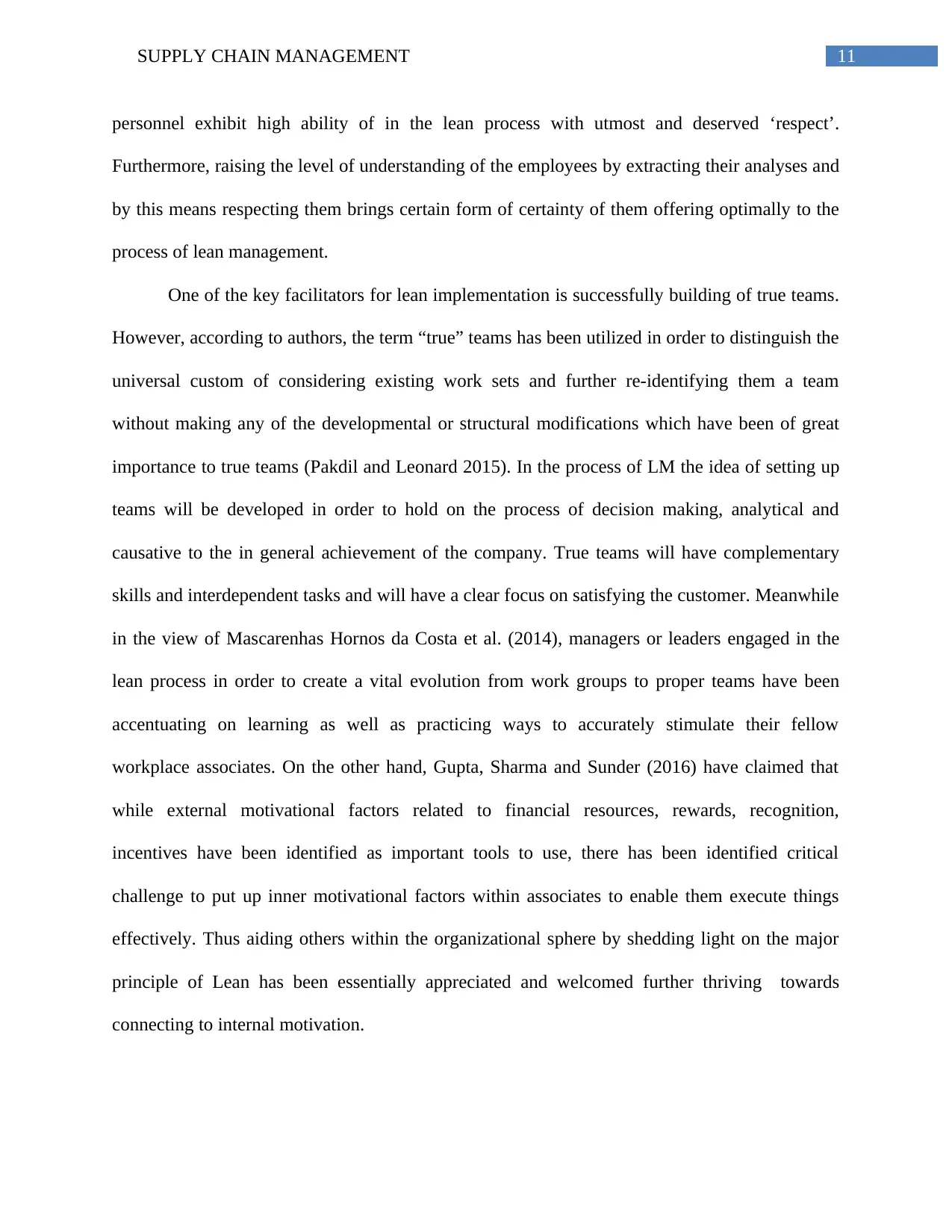
11SUPPLY CHAIN MANAGEMENT
personnel exhibit high ability of in the lean process with utmost and deserved ‘respect’.
Furthermore, raising the level of understanding of the employees by extracting their analyses and
by this means respecting them brings certain form of certainty of them offering optimally to the
process of lean management.
One of the key facilitators for lean implementation is successfully building of true teams.
However, according to authors, the term “true” teams has been utilized in order to distinguish the
universal custom of considering existing work sets and further re-identifying them a team
without making any of the developmental or structural modifications which have been of great
importance to true teams (Pakdil and Leonard 2015). In the process of LM the idea of setting up
teams will be developed in order to hold on the process of decision making, analytical and
causative to the in general achievement of the company. True teams will have complementary
skills and interdependent tasks and will have a clear focus on satisfying the customer. Meanwhile
in the view of Mascarenhas Hornos da Costa et al. (2014), managers or leaders engaged in the
lean process in order to create a vital evolution from work groups to proper teams have been
accentuating on learning as well as practicing ways to accurately stimulate their fellow
workplace associates. On the other hand, Gupta, Sharma and Sunder (2016) have claimed that
while external motivational factors related to financial resources, rewards, recognition,
incentives have been identified as important tools to use, there has been identified critical
challenge to put up inner motivational factors within associates to enable them execute things
effectively. Thus aiding others within the organizational sphere by shedding light on the major
principle of Lean has been essentially appreciated and welcomed further thriving towards
connecting to internal motivation.
personnel exhibit high ability of in the lean process with utmost and deserved ‘respect’.
Furthermore, raising the level of understanding of the employees by extracting their analyses and
by this means respecting them brings certain form of certainty of them offering optimally to the
process of lean management.
One of the key facilitators for lean implementation is successfully building of true teams.
However, according to authors, the term “true” teams has been utilized in order to distinguish the
universal custom of considering existing work sets and further re-identifying them a team
without making any of the developmental or structural modifications which have been of great
importance to true teams (Pakdil and Leonard 2015). In the process of LM the idea of setting up
teams will be developed in order to hold on the process of decision making, analytical and
causative to the in general achievement of the company. True teams will have complementary
skills and interdependent tasks and will have a clear focus on satisfying the customer. Meanwhile
in the view of Mascarenhas Hornos da Costa et al. (2014), managers or leaders engaged in the
lean process in order to create a vital evolution from work groups to proper teams have been
accentuating on learning as well as practicing ways to accurately stimulate their fellow
workplace associates. On the other hand, Gupta, Sharma and Sunder (2016) have claimed that
while external motivational factors related to financial resources, rewards, recognition,
incentives have been identified as important tools to use, there has been identified critical
challenge to put up inner motivational factors within associates to enable them execute things
effectively. Thus aiding others within the organizational sphere by shedding light on the major
principle of Lean has been essentially appreciated and welcomed further thriving towards
connecting to internal motivation.
⊘ This is a preview!⊘
Do you want full access?
Subscribe today to unlock all pages.

Trusted by 1+ million students worldwide
1 out of 17
Related Documents
Your All-in-One AI-Powered Toolkit for Academic Success.
+13062052269
info@desklib.com
Available 24*7 on WhatsApp / Email
![[object Object]](/_next/static/media/star-bottom.7253800d.svg)
Unlock your academic potential
Copyright © 2020–2025 A2Z Services. All Rights Reserved. Developed and managed by ZUCOL.





